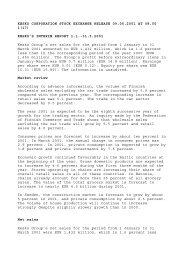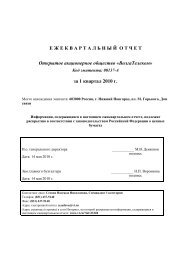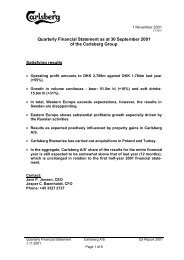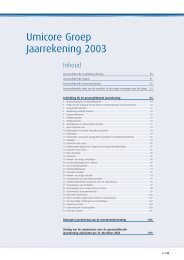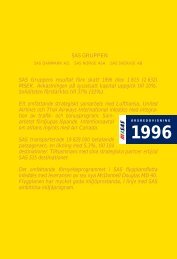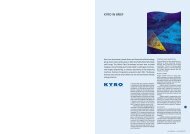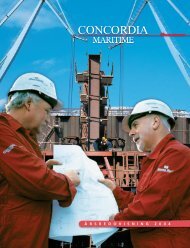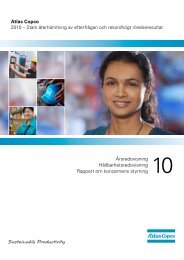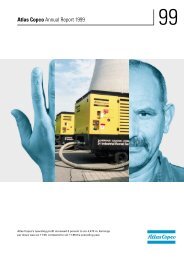össur annual report2009 - Euroland
össur annual report2009 - Euroland
össur annual report2009 - Euroland
Create successful ePaper yourself
Turn your PDF publications into a flip-book with our unique Google optimized e-Paper software.
3.11 share-based payMents<br />
Equity-settled share-based payments to employees and<br />
others providing similar services are measured at the fair<br />
value of the equity instruments at the grant date. Details<br />
regarding the determination of the fair value of equity-settled<br />
share-based transactions are set out in note 26.<br />
The fair value determined at the grant date of the equitysettled<br />
share-based payments is expensed on a straightline<br />
basis over the vesting period, based on the Company’s<br />
estimate of equity instruments that will eventually vest. At<br />
the end of each reporting period, the Company revises its<br />
estimate of the number of equity instruments expected<br />
to vest. The impact of the revision of the original estimates,<br />
if any, is recognised in profit or loss such that the<br />
cumulative expense reflects the revised estimate, with a<br />
corresponding adjustment to the equity-settled employee<br />
benefits reserve.<br />
3.12 taXation<br />
Income tax expense represents the sum of the tax currently<br />
payable and deferred tax.<br />
CURRENT TAX<br />
The tax currently payable is based on taxable profit for the<br />
period. Taxable profit differs from net profit as reported<br />
in the income statement because it excludes items of<br />
income or expense that are taxable or deductible in other<br />
periods and it further excludes items that are never taxable<br />
or deductible. The Consolidated Company’s current tax<br />
liability is calculated using the tax rates for each country.<br />
DEFERRED TAX<br />
Deferred tax is recognised on differences between the carrying<br />
amounts of assets and liabilities in the Consolidated<br />
Financial Statements and the corresponding tax bases<br />
used in the computation of taxable profit, and is accounted<br />
for using the balance sheet liability method. Deferred tax<br />
liabilities are generally recognised for all taxable temporary<br />
differences, and deferred tax assets are generally recognised<br />
for all deductible temporary differences to the extent<br />
that it is probable that taxable profits will be available<br />
against which those deductible temporary differences can<br />
be utilised. Such assets and liabilities are not recognised if<br />
the temporary difference arises from goodwill or from the<br />
initial recognition (other than in a business combination)<br />
of other assets and liabilities in a transaction that affects<br />
neither the taxable profit nor the accounting profit.<br />
Deferred tax liabilities are recognised for taxable temporary<br />
differences associated with investments in subsidiaries<br />
and associates, and interests in joint ventures, except<br />
where the Company is able to control the reversal of the<br />
temporary difference and it is probable that the temporary<br />
difference will not reverse in the foreseeable future.<br />
Deferred tax assets arising from deductible temporary differences<br />
associated with such investments and interests<br />
are only recognised to the extent that it is probable that<br />
there will be sufficient taxable profits against which to<br />
utilise the benefits of the temporary differences and they<br />
are expected to reverse in the foreseeable future.<br />
The carrying amount of deferred tax assets is reviewed at<br />
each balance sheet date and reduced to the extent that it<br />
is no longer probable that sufficient taxable profits will be<br />
available to allow all or part of the asset to be recovered.<br />
Deferred tax assets and liabilities are measured at the<br />
tax rates that are expected to apply in the period in which<br />
the liability is settled or the asset realised, based on tax<br />
rates (and tax laws) that have been enacted or substantively<br />
enacted at the balance sheet date. The measurement<br />
of deferred tax liabilities and assets reflects the tax consequences<br />
that would follow from the manner in which<br />
the Company expects, at the reporting date, to recover or<br />
settle the carrying amount of its assets and liabilities.<br />
Deferred tax assets and liabilities are offset when there<br />
is a legally enforceable right to set off current tax assets<br />
against current tax liabilities and when they relate to<br />
income taxes levied by the same taxation authority and the<br />
Company intends to settle its current tax assets and liabilities<br />
on a net basis.<br />
In the preparation of the Consolidated Financial<br />
Statements, accumulated gains in inventories from intercompany<br />
transactions are eliminated. This has an effect<br />
on the income tax expenses of the consolidated companies,<br />
and an adjustment is included in the deferred tax<br />
asset. Income tax expense is calculated in accordance with<br />
tax rates in the countries where the inventories originate.<br />
3.13 property, plant and equipMent<br />
Property, plant and equipment are recognised as an asset<br />
when it is probable that future economic benefits associated<br />
with the asset will flow to the consolidation and the<br />
cost of the asset can be measured in a reliable manner.<br />
Property, plant and equipment which qualifies for recognition<br />
as an asset is initially measured at cost.<br />
The cost of a property, plant and equipment comprises its<br />
purchase price and any directly attributable cost of bringing<br />
the asset to working condition for its intended use.<br />
The depreciable amount of the asset is allocated on a<br />
straight-line basis over its useful life. The depreciation<br />
charge for each period is recognised as an expense. The<br />
estimated useful lives, residual values and depreciation<br />
method are reviewed at each year end, with the effect of any<br />
changes in estimate accounted for on a prospective basis.<br />
All amounts in thousands of USD 69 <strong>annual</strong> report 09<br />
Össur hf. consolidated financial stateMents 2009



